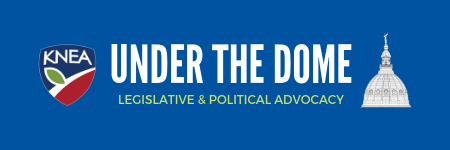 Guns for Teachers
Guns for Teachers
We’ve been wondering how long it would be before Kansas legislators got around to proposing the arming of teachers in our schools. Today’s the day.
Enter House Bill 2789 and Senate Bill 424, both creating the so-called “SAFER Act.” In the clever “language that means the opposite of what it actually does” world of ultra-conservatives, the bill purports to create the “Kansas Staff As First Emergency Responders act.” In this case, the “first emergency responders” would be classroom teachers.
Under the bill, school districts can supposedly choose to arm teachers and such teachers must hold a concealed carry permit and an additional level of permit known as the SAFER permit. These teachers would then be expected to pack a weapon at school and then confront an armed assailant. The bill makes no provision for law enforcement to determine who might be the “bad shooter(s)” and who might be the “good shooter(s)” when the SWAT team arrives to find multiple people with weapons drawn and engaged in gunfire.
But before you think this is an exercise in “local control” for school districts, a section of the bill specifically states that in schools where teachers are not armed, should an incident take place the school district is deemed to have been negligent should there be a lawsuit or other court action.
Instead of providing resources to ensure that school buildings are secure; instead of passing legislation to control the proliferation of assault rifles (the weapon of choice in mass shootings, read more here) including universal background checks; instead of providing resources for mental health providers, HB 2789 and SB 424 simply throw guns at the problem and hope Miss Smith will just go out in the hall and shoot an intruder. Problem solved.
Kansas NEA’s position is that the safest schools are gun-free schools where the only armed persons on any school campus should be trained and licensed law enforcement personnel. Our position is an informed position having consulted with law enforcement officials who train schools, businesses and community organizations for active shooter occurrences. Our position aligns with our long-standing core values.
We feel it important to recognize as this debate continues to grow, that more teachers names will be engraved on the Memorial to Fallen Educators in Emporia, Kansas this June including the names of those that died to protect their students at Marjory Stoneman Douglas High School in Parkland, Florida.
Bill Bundling in the Senate Select School Finance Committee
Four bills were scheduled to be worked today in the Senate Select School Finance Committee today and worked they were!
Two of the bills – SB 422 and SB 423 – dealt with equity issues in SB 19 found to be unconstitutional by the Supreme Court. The other two – SB 352 and SB 450 – dealt with the transportation formula.
They started with SB 450, the bill by Sen. Bollier (R-Mission Hills) that addressed the “curve of best fit” in the transportation formula. Bollier proposed two amendments, both of which were adopted. The first directs the State Board of Education to determine how best to measure the distance from school to home for the purposes of determining whether or not a student met the 2.5-mile minimum distance. The second put in a grandfather clause intended to protect districts from negative changes.
Before moving SB 450 out of committee, they took up SB 352, a bill moving the funding of the transportation formula out of the State Highway Fund and into the State General Fund. This would save $107.3 million in highway money but require either an additional $107.3 million in general fund money for schools or for schools to simply absorb the cost of transportation in their budgets.
The Committee voted to bundle SB 450 into SB 352 and pass SB 352 out of committee and on to the full Senate.
Next up was SB 422, the bill mandating a 30% LOB, requiring notice to the State Board of Education of intent to increase the LOB by March 15, requiring a protest petition for LOB increases, requiring the transfer of some LOB funds to the at-risk fund, and linking state aid to the current year LOB. Two of the provisions in this bill are intended to address equity issues flagged by the Supreme Court (see bold type).
After much wrangling, the mandate 30% LOB was removed as was the required transfer to the at-risk fund. All other provisions remained the same.
Before passing the bill as an amendment, the Committee took up SB 423 which deals with the other two equity issues addressed in the Gannon decision. SB 423 would repeal the 10% at-risk floor and the expanded uses for capital outlay funds.
The Committee bundled the two bills together and sent the bill on to the full Senate for consideration.
House K-12 Budget Committee Also Dealing with Equity Provisions
The House Committee was also dealing the transportation and equity but instead of four bills, they had one, HB 2445.
Their work is not finished but today they approved a number of amendments to the bill.
An amendment by Rep. Melissa Rooker (R-Fairway) would restructure a list of scheduled LPA audits required under SB 19. Her amendment would remove reviews of the successful schools model of school funding (peer reviews found them to be not credible and lacking in rigor), re-order some studies of specific programs, and require cost function analysis “refreshers” every three years. The amendment was adopted along with one adjustment by Rep. Clay Aurand (R-Belleville) to move the special education review to 2019 and the virtual education review to 2023.
Another Rooker amendment to strike sunset dates on CTE funding and high density at-risk was adopted. Her third amendment removed the hoops that school districts have to jump through to get capital improvement state aid. That amendment also passed.
Rep. Adam Smith (R-Weskan) made two attempts to change a provision lowering aid for out-of-state students which is scheduled to decline from 1.0 to 0.5 over a couple of years. His first attempt would simply repeal the reduction. That amendment failed.
Smith then proposed another amendment that would allow certain students to be fully funded and funding was essentially determined by geography – distance from the border of the student’s home state school and the Kansas school of attendance and other factors. After some discussion, Smith withdrew the amendment to give time for interested members of the committee to discuss the issue and craft a new amendment.
The Committee adjourned for the day with the understanding that they will be coming back to the bill later.



